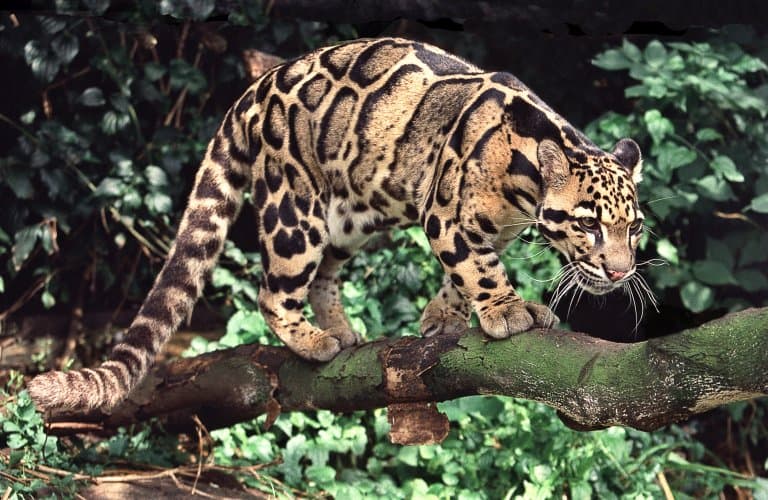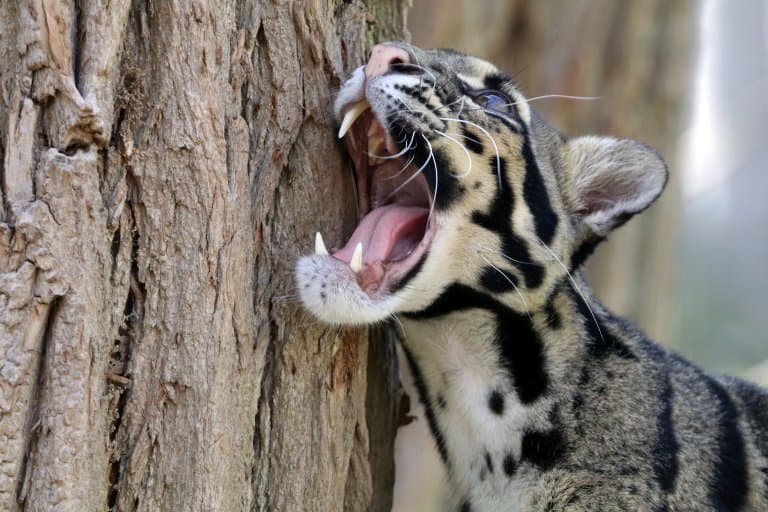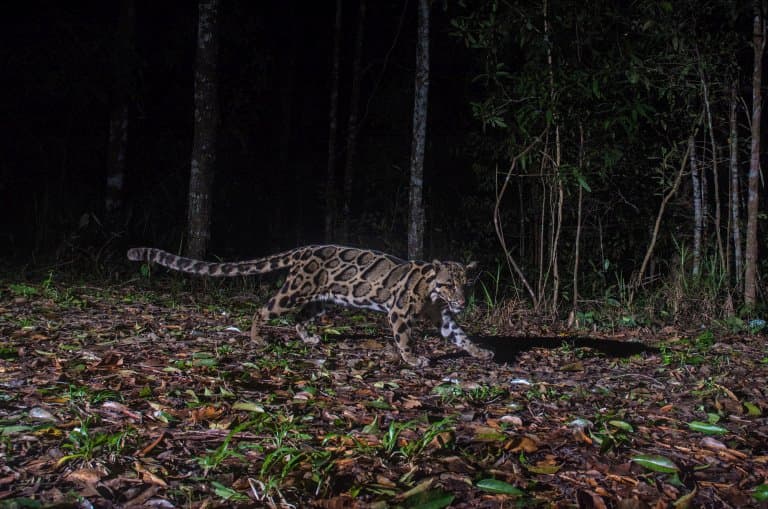Clouded Leopard Profile
The clouded leopard is an elusive and mysterious species of wild cat; they are rarely seen in the wild and not very much is known about them.
They inhabit forested areas in southern and eastern Asia, and can be found from Indonesia to Nepal, Borneo, Indochina, and into Taiwan and south China.
They prefer tropical rainforests, although they have also been seen in dry forests, the forested foothills of the Himalayas (even up to 9,000ft), and have even been spotted in mangrove forests in Borneo.
It is believed that their population is most stable in Borneo since there are no threats from tigers or leopards. Fairly little is known about their population size and are classified as vulnerable.

Clouded Leopard Facts Overview
| Habitat: | Cloud forests, tropical lowland forest, dry woodland, even swamps |
| Location: | Southeast Asia, eastern Himalayas |
| Lifespan: | 11 years |
| Size: | Up to 80cm (height), up to 110cm (length) |
| Weight: | Up to 50lbs |
| Color: | Brown/yellow-gray, irregular spots and patches |
| Diet: | Birds, squirrels, monkeys, pigs, deer |
| Predators: | Tigers, possibly leopards, humans |
| Top Speed: | 64 kph (40 mph) |
| No. of Species: |
1 |
| Conservation Status: |
Vulnerable |
The clouded leopard, also known as the mainland clouded leopard (Neofelis nebulosa) is a member of the genus Neofelis, which also includes the Sunda clouded leopard (Neofelis diardi), which is only found in Sumatra and Borneo, and considered a distinct species.
Clouded leopards are relatively small in size, ranging from 69 to 108 cm (27 to 43 inches). Females are significantly smaller than males, weighing between 25-35lbs, compared to males which can weigh up to 50lbs. This size difference is the largest discrepancy between male and female of a species in the cat family.
They have a distinctive coat: coloured brown and a yellowish-grey, with different sized spots, stripes and blotches. Recent sightings in Borneo have suggested there may also be black and albino forms of their colouring. The clouded leopard’s unique coat has long been desirable in the fashion world, and they are still heavily hunted and poached for their skins, as well as teeth, bones and claws.
Clouded leopards are arboreal and primarily nocturnal. This means they are very strong climbers – in fact, they are up there as some of the best in the feline world. They have large paws with specialized foot pads and sharp claws for gripping branches; and they have stocky, powerful legs with rotating rear ankles. They nimbly clamber up and down tree trunks and from branch to branch, using their long tails for balance. Clouded leopards are also equipped with excellent eyesight and the stealthy movement common in wild cats.
Despite their arboreal agility, they do most of their hunting on the ground, stalking their prey or occasionally ambushing from trees. They are carnivores, and their diet of choice includes gibbon, macaques, wild boar, small deer, rodents and birds
As with most cats, clouded leopards are generally assumed to be solitary creatures. Females produce a litter of between one and five cubs per year. Leopard cubs are dependent on their mother up to around 10 months but often remain with her for up to 1 and a half years, becoming sexually mature at 2 years.
The population of clouded leopards is decreasing, and they are currently considered vulnerable, threatened by large-scale deforestation and commercial poaching with estimations of around only 10,000 individuals living in the wild.
Interesting Clouded Leopard Facts
1. Clouded leopards are not leopards
Despite the name, clouded leopards are actually not a type of leopard, but are a separate species entirely, just like a snow leopard.
They are not that closely related and in a different genus ‘Neofelis’. True leopards are in the genus Panthera, alongside tigers, lions, jaguars and the snow leopard.

2. They are named for the distinctive ‘clouds’ on their coats
The coats of clouded leopards are covered in irregular spots and patches of a pale grey/brown colour surrounded by a darker edge or line. These cloud-like blotches are what give the animal their common name of clouded leopard.
In Malaysia, the clouded leopard is known as the ‘tree tiger’, while in China they are named the ‘mint leopard’, because the patches on their coats resemble mint leaves.
3. They have the largest teeth to body size
Clouded leopards have the biggest canine teeth – in proportion to their body size – of any wild cat; almost resembling the now extinct sabretooth.
With sizes up to 2 inches in length, their canine teeth are the same size as a tiger’s, despite being 10 times smaller in body size. Their large, sharp teeth aid their excellent hunting skills. 1

4. Clouded leopards can descend trees headfirst
Their strong and stocky legs are equipped with rotating ankles which allow varied climbing positions and therefore enable clouded leopards to quickly and agilely scale up and down trees headfirst – like squirrels.
They are also able to climb while hanging upside-down beneath the branches, and even to hang only from their back feet in order to snatch prey with their front legs. 2
5. The clouded leopard may be the most ancient of the big cats
Recent studies have indicated that the clouded leopard was the first species of the Pantherinae family to branch from the other members – over 6 million years ago.
This would make the clouded leopard the most ancient feline of all modern cat species.
6. The clouded leopard cannot roar or purr
These cats have a different structure of bones in their neck which means they lack the ability to roar like the other big cats. They also lack the hyoid bone which enables small cats to purr.
The clouded leopard’s alternative communication methods include high-pitched meow calls, hissing, growling and chuffing.

7. Clouded leopards have an extreme gape
They are able to open their mouths extremely wide – to around 100 degrees. This is another feature that assists their hunting, and gives them the ability to take down larger prey.
8. Clouded leopards are strong swimmers
Somewhat surprisingly, given the common acceptance that cats hate water, clouded leopards are very confident swimmers.
It is thought that this may be how they populated small islands off the coast of Vietnam and Borneo.
9. Their eyes are unique
In contrast to other cats, clouded leopards’ pupils never enlarge to a fully round shape like big cats nor to a thin slit like small cats.
Instead, their pupils are constantly an oblong shape.

10. Clouded leopards have some reproductive challenges
Although most cats are considered induced ovulators (meaning that the act of copulation induces ovulation), it has not been possible to determine whether this is the case for the clouded leopard, as the females are able to spontaneously ovulate – however this is generally considered to be intermittent.
Their ovulation being so unpredictable can cause some challenges for reproduction in this species, when coupled with the fact that around 70% of the males have malformed sperm.
In human care, artificial insemination has been used with sporadic success. It has also proved to be a challenge to find compatible mates for reproduction, as there is a high level of aggression seen between males and females of the same age.
11. Clouded leopards are considered to bridge the gap between big cats and small cats
All cat species are related to the same family of Felidae, but genetics have shown that the clouded leopard is more closely related to big cat species.
However, due to its small stature, the clouded leopard is often described as filling the gap between big and small in the feline world: they are bigger than small cats and smaller than big cats!
12. The population of the clouded leopard declined rapidly in the 20th century
This is due entirely to human action from poaching and deforestation destroying their habitat.
Sadly the clouded leopard is thought to be locally extinct in Singapore, Taiwan, Hainan Island and Vietnam.
The clouded leopard is listed in CITES Appendix I and protected over most of its range with hunting banned, although bans are poorly enforced in some countries and poaching continues. 3
Clouded Leopard Fact-File Summary
Scientific Classification
| Kingdom: | Animalia |
| Phylum: | Chordata |
| Class: | Mammalia |
| Order: | Carnivora |
| Family: | Felidae |
| Genus: | Neofelis |
| Species Name: |
Neofelis Nebulosa |
Fact Sources & References
- “Clouded leopards“, WWF.
- Wild Cat Conservation (2014) “Clouded Leopard“, International Society for Endangered Cats (ISEC) Canada.
- Channing Sargent (2022) “Once thought extinct, meet the fascinating, rare Formosan clouded leopard“, OneEarth.
